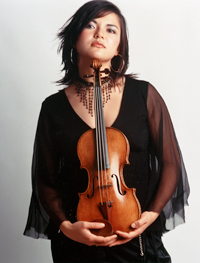by Mike Telin

Upon answering the phone in Switzerland, the extremely gracious Karen Gomyo immediately thanked me for calling her in Europe. No problem I tell her, I’m calling her on Skype. Gomyo uses our brief opening conversation to talk about all that is wonderful with modern technology, and how easy it makes our lives, as the perfect lead-in to talking about the Saint-Saëns concerto. “It’s funny because I read somewhere that Pablo Sarasate, just knocked on Saint-Saëns’s door and asked him for a concerto. That is unthinkable these days because, like you said, we have all these modes of communication. But I guess back in that time you could really just show up in person.”
Saint-Saëns dedicated his third violin concerto to Sarasate who premiered the work in October of 1880. In addition to being an audience favorite, the work is also a favorite of Karen Gomyos. “I grew up with the Nathan Milstein recording and it has been one of my favorites ever since I was a little girl, so it has a special place in my heart.
What I love about the music is that it is just so beautiful,” she said, adding that the concerto is deceivingly difficult, technically. “Saint-Saëns was a pianist and so it is not the most [idiomatic] writing in the way that the Wieniawski concerto is.”
In spite of that, Gomyo does think the concerto is filled with imagination and creativity. “There are just so many things that hadn’t been done before. For example, one of my favorite moments in the piece is at the end of the second movement where the violin is playing octaves arpeggios together with the clarinet. It is so beautiful, but this was a really new thing that still doesn’t quite exist in the same way in violin repertoire. It is virtuosic but also extremely elegant. These are aspects I really enjoy about this piece.”
Karen Gomyo was born in Tokyo to a Japanese mother and French-Canadian father and was raised in Montréal. She is fluent in French, English and Japanese. How has speaking multiple languages combined with growing up in a city as culturally diverse as Montréal influenced her outlook on music and life? “It is interesting to me because I went to a local public elementary school. Now that I’m thinking about it I realize just how diverse it was ethnically and I think that international environment was very natural to me. I never grew up thinking of myself as being half Asian and half Caucasian, I was just one of the many kids who had different dreams and different goals in life. “
Gomyo recalled the first time she actually thought about her cultural identity. “I was a student at Juilliard and I got to play for Pinchas Zuckerman. Interestingly, his first question to me was ‘what language do you play your music in?’ I had never thought about that, and I still don’t really know if it’s necessary to choose one. I think that I am a unique combination as much as somebody else is a unique combination of their own background. And ultimately, today’s world is just so much more mixed then it used to be. I think it’s a wonderful thing to be able to travel to different countries or to work with people who are from different places and from different musical backgrounds. I certainly learn a lot from my colleagues just by interacting with them. So I feel that maybe being brought up with multiple languages and ethnicities has made that process all the more natural.”
In addition to “classical” music, Karen Gomyo has a deep passion for Tango Nuevo, specifically the music of Astor Piazzolla. She has an ongoing project with Piazzolla’s longtime pianist and tango legend Pablo Ziegler and his partners Hector del Curto (bandoneon), Claudio Ragazzi (electric guitar), and Pedro Giraudo (double bass). I tell her that I also have a passion for the genre and that while it may be a silly question, how did she become interested in the music of Piazzolla? “That’s not a silly question, especially coming off the previous question. I had a Spanish speaking babysitter, in fact I grew up in a Hispanic neighborhood, so I heard a lot of Latin music. I don’t know if any of it was specifically Tango music, but certainly the Latin culture was very much a part of my upbringing.
She recalled hearing Piazzolla’s music for the first time at age fourteen. “My mother had gotten me a CD of his music, because she had the great privilege to hear him live in a smoky bar in Montréal as she describes it. And when she came across this CD many years later she just had this instinct that I would really love his music. She was absolutely right, I just completely fell in love with it.”
How did the musical relationship with Palbo Ziegler come about? “I had a chance meeting with Pablo at a music festival about eight years ago. I knew the program was Tango music but I didn’t really know who would be playing. When the pianist walked in, my jaw just dropped to the floor because it was Pablo Ziegler. I immediately recognized him from all of the Montréal Jazz Festival videos where he was playing with Piazzolla. So that was my first meeting with Pablo, and it was very much a star-struck moment with me, but he was incredibly generous and kind and friendly. We got to talking and one thing led to another and we came up with these projects. Now we play together and I’m good friends with Hector as well. And that’s how it all came about.”
Published on ClevelandClassical.com July 15, 2014.
Click here for a printable copy of this article.



